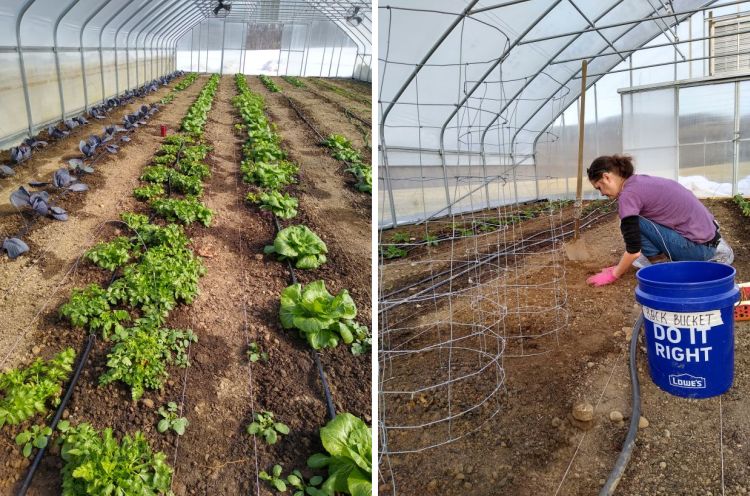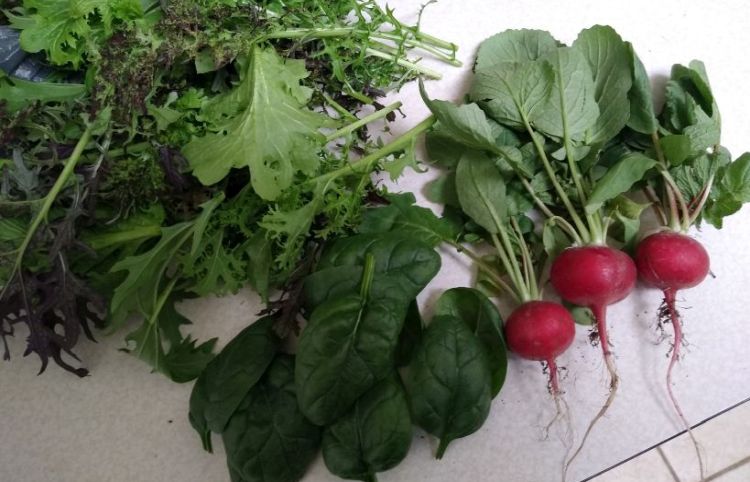ECO-Vrindaban Prepares For Another Plentiful Growing Season
By Madhava Smullen | Mar 13, 2021

Non-profity entity ECO-Vrindaban, which works closely with ISKCON New Vrindaban in West Virginia on ISKCON’s first farm, is preparing for another growing season. Its mission statement? To “promote cow protection, local agriculture, and above all, loving Krishna, as envisioned by Srila Prabhupada.”
Typically, the season for outdoor gardening in the area begins around mid-May, after the last frost, and runs until October-November. However ECO-V’s high tunnel greenhouses, installed in Summer 2019, allow devotees to offer locally grown flowers and vegetables to Sri Sri Radha Vrindaban Chandra and the temple kitchens all year round.
Two of the high tunnels, measuring 96 x 30 feet each, sit near the Valley Barn. The third, measuring 60’ x 30’, is in the personal garden of Vidya Dasi, a village resident who has served in the community for fifty years.
“One of the high tunnels at the Valley Barn was completely full all winter,” says ECO-V Garden Manager Analaksita Dasi. “In just a few weeks we’re going to be harvesting spinach, purple kale, green kale, red cabbages, Chinese cabbages, carrots, beets, Swiss chard, and radishes.”
While tomatoes are usually not planted until about May 20th, around 67 tomato plants are already growing in the high tunnel at Vidya Dasi’s property.
Plenty of preparation had to be done over the fall to ensure such success, including fixing irrigation and ventilation problems in the high tunnels, putting in exhaust fans, disinfecting, and prepping the soil. “We also have to cover and uncover all of the plants every day, when the temperature goes below 32 degrees,” says Analaksita.

(left) High tunnel 1 planted with carrots, beets, spinach, swiss chard, red cabbage, tomatoes, celery, red and daikon radishes, brussel sprouts, dahlias and tuberroses (right) Lifelong New Vrindaban resident Sucandra Dasi plants Dahlias in high tunnel 2.
In preparation for the growing season, a growth station has been built in Analaksita’s office, where broccoli, cauliflower, brussel sprouts, okra, bitter melon, and romaine lettuce are sprouting. These will then be planted outside in May, in the high tunnels as well as in village residents’ gardens such as those of Vidya Dasi and Lalita Gopi Dasi.
A brand new 60 x 80 foot outdoor garden is also being established near the Valley Barn, where more produce including hot peppers, bell peppers, peas, butternut squash, spaghetti squash, watermelon, cantaloupe and strawberries will be grown.
Potatoes will be grown at the Community Garden, and flowers for the Deities at the Teaching Garden, which is overseen by Sucandra Dasi. Analaksita is beginning to propagate fig trees, and there are already existing apple trees and blueberry bushes on the property.
As well as supplying the Deities and temple kitchen, produce will be on sale at a farmer’s market in the Teaching Garden across the street from the ISKCON New Vrindaban temple, on Saturdays and Sundays from June to October. “The farmer’s market gives the devotees that don’t live in the temple the opportunity to buy the vegetables that we grow ourselves,” Analaksita says.
Meanwhile in cow protection, which Srila Prabhupada wrote “should be the main business of New Vrindaban” in a 1968 letter, ECO-Vrindaban will prepare for the season by harvesting hay starting in May, and putting up between 800 and 1,000 round bales for the cows.
ECO-V is currently caring for 67 cows in total at its Nandagram farm and the Valley Barn, including retired cows, bulls, calves, heifers, and steers.
Eight cows are being milked at the Radha Vrindaban Chandra Goshala near the temple — Sita, Sriya, Lalita, Usha, Jayasri, Gaurangi, Gopi Katyayani, and Subhadra. The 26 gallons of milk they produce a day, and the 20 to 30 pounds of butter cowherd Anandavidya makes per week from it, supply the Deities with dairy as well as supplementing the needs of temple devotees.

Kaleabration Salad Mix (a mix of baby kales), spinach and River Red Radishes grown in high tunnel 1. These have been harvested and delivered to Sri Sri Radha Vrindaban Chandra’s temple along with purple and green kale.
Looking to the future, Analaksita hopes to be able to grow enough food to provide for the whole temple and the community as well as the Deities, inspired by Srila Prabhupada’s vision for New Vrindaban.
Long-term, she also would like to build several mini-houses and create a small eco-village down by the high tunnels for devotees who have a propensity for growing food, taking care of cows, and making their livelihood from such services.
“As I understand, Srila Prabhupada wanted us to live more simply, so we had more time for our God consciousness and our chanting,” she explains. “And also, so that everybody could see Krishna in everything – every tree, every leaf, every plant that we water. So I would like to be able to build a small model of what Prabhupada envisioned for Varnashrama Dharma. Perhaps it could include some Krishna conscious mentorship programs where we could teach the youth skills such as how to grow food, how to build a house, and how to take care of the cows.”
This kind of simple natural lifestyle, working together, and caring for the devotees, Analaksita feels, is an important part of the Krishna conscious community Srila Prabhupada wanted.
“Prabhupada says that agriculture and cow protection are the number one priorities for the residents of Vrindaban, and above all, loving Krishna,” she points out. “Krishna is in each of our hearts, so if we love each other, we’re also loving Krishna.”















